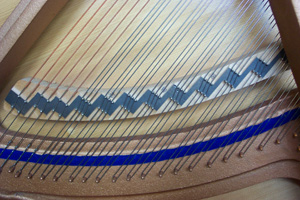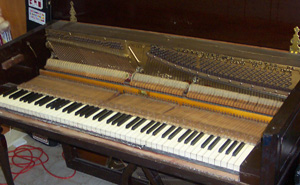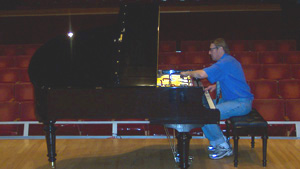
Tuning
Tuning your Piano
Standard Pitch Tunings
 All new and most used pianos are designed to be tune to A-440 Hz., or, what is referred to as "Standard Pitch".
All new and most used pianos are designed to be tune to A-440 Hz., or, what is referred to as "Standard Pitch".
This means that the strings corresponding to key 'A" to the right of the key "middle C" are tuned to vibrate 440 times per second. All other strings/notes or keys are directly or indirectly tuned to this note or key through a systematic procedure of adjusting the tension on all strings so that all the strings /notes /keys on the piano are in tune with each other. Emphasis is also place on "setting the pin", that is, making sure the position of the pin in the pin block is stable and will remain in the correct position to keep the string tension constant when the tuning is complete. Your piano was engineered and designed so the string tension at "Standard Pitch" creates the correct amount of pressure on the bridge and soundboard of the piano to produce the most beautiful, rich, harmoniously sustained tone your piano can offer.
All manufacturers of pianos recommend having the piano tuned at least twice a year to achieve a durable, stable tuning. All pianos that are tuned regularly can be maintained at the standardized pitch of A 440 Hz. This is the optimal end result of having a piano tuned. If you do this your piano will sound fabulous!
Below Standard Pitch Tunings
For a variety of reasons, some pianos may sit idle for an extended period of time without being tuned or maintained. As a result, the tension on the strings gradually relaxes, the piano becomes out of tune, and the relative pitch drops significantly below "Standard Pitch".
 I have encountered pianos that are as much as a quarter tone or halftone flat as a result of sitting idle for 2-10 years. Needless to say, these pianos are horribly out of tune. I usually get called to tune these pianos because the player is playing the correct notes/keys but it sounds like they are playing the wrong notes/keys. This can be especially confusing to beginning piano players.
I have encountered pianos that are as much as a quarter tone or halftone flat as a result of sitting idle for 2-10 years. Needless to say, these pianos are horribly out of tune. I usually get called to tune these pianos because the player is playing the correct notes/keys but it sounds like they are playing the wrong notes/keys. This can be especially confusing to beginning piano players.
To try to restore the string tension on these pianos in one tuning to standard pitch is usually not a good idea. You run the risk of string breakage from adding so much tension, bridge damage or soundboard damage that may manifest itself loosened bridge pins and/or one or more cracks in the soundboard.
Is it a hopeless case? No! Not at all! The piano can still be tuned so it sounds wonderful, it will just be at a lower pitch! As with other tunings, extra care is given to "setting the pin". This ensures that the tuning, when completed, remains as stable as possible. Each time you have the piano tuned thereafter, the tension can usually be gradually increased so as not to cause string breakage, bridge damage or soundboard damage, and, if you have the piano tuned regularly you can, in most cases, eventually have the pitch restored to "Standardized Pitch"!
A couple of exceptions to the case of the Sub-Standard pitch piano being restored to "Standard Pitch" involve very old pianos with pin blocks that cannot hold the tuning pins in place with the correct tension on them or if the strings of a piano have become weakened by an abundance of rust or corrosion
Concert Tunings
 A concert tuning is performed on pianos that are typically prepared for concerts, recitals, recording studios, churches, theatres, schools and other institutional settings. Extra attention is given to make the tuning perfect and stable (setting the pin, equalizing string tension throughout the length of the strings, etc.) so as the piano is played with vigor the instrument meets the exacting demands of the professional performing artist. This tuning may also require voicing of the hammers, adjustment or regulation of the action, pedals, sostenuto system or dampers to bring out the best in the piano.
A concert tuning is performed on pianos that are typically prepared for concerts, recitals, recording studios, churches, theatres, schools and other institutional settings. Extra attention is given to make the tuning perfect and stable (setting the pin, equalizing string tension throughout the length of the strings, etc.) so as the piano is played with vigor the instrument meets the exacting demands of the professional performing artist. This tuning may also require voicing of the hammers, adjustment or regulation of the action, pedals, sostenuto system or dampers to bring out the best in the piano.
 Pitch Raise
Pitch Raise
A pitch raise is performed on a piano that is determined to be significantly below standardized pitch and it is also determined that the piano can withstand the significant increase in string tension without causing string breakage, bridge or soundboard damage.
It is a three step process: First the tension on all strings must be increased to get the relative pitch "in the ball park" of standardized pitch. Then the piano must be tuned. Finally, the pitch of every string must be re examined to determine that the pitch has remained constant, retuning where necessary and adjusting the position of the tuning pins so the pin is not torqued or twisted from the rigors of a pitch raise. This is often referred to as "setting the pin". It is not uncommon for a pitch raised piano to need an adjustment in a month or so because the increased tension on some strings may actually cause the string to stretch and as it does it will drift out of tune.